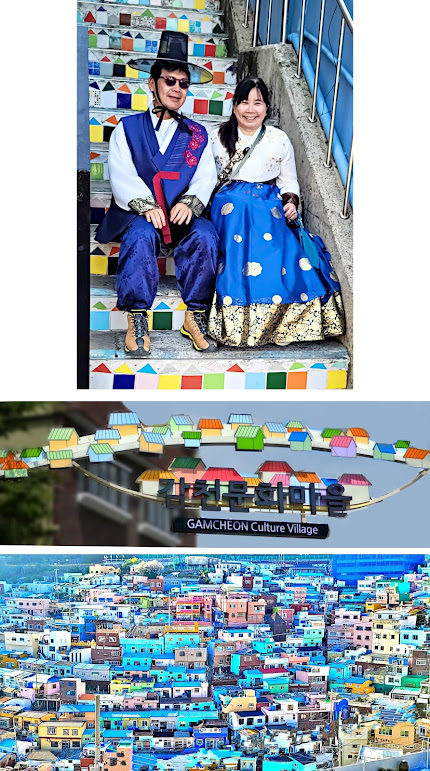
|
| Hiked up to the bowl crater of Seongsan Ilchulbong on Jeju Island. |
My aim over the next few months is to explore new (to me) parts of six previously visited countries. I'm starting with Korea's Jeju Island and Busan, its second largest city, along with its historic old capital Gyeongju.
South Korea is a big deal, of course. With the world's 12th largest economy, it's the home to powerful conglomerates such as Samsung, Hyundai, LG, Kia, and POSCO.
Who knows how long this progress can last now that the birth rate has fallen to the lowest in the world — but for now Korea is going strong. Its 52 million people typically earn incomes higher than do residents of Japan and Spain, and they are not far behind Brits and Kiwis.
Jeju Island 제주도
Jeju is South Korea's one "big" island but it is about half the size of Luxemburg. It's a tourist attraction due to its volcanic landscapes, lush forests, and some pretty beaches. I'd been seeing more mentions of Jeju recently and decided to check it out.
Above you see my photo after hiking up to the bowl crater of Seongsan Ilchulbong, the most popular spot on Jeju. A view of the crater from the shoreline is pictured on the right.
Seongsan Ilchulbong provided an enjoyable steep hike up to the top. But, unfortunately, the "traditional village" consisted of some (disappointing) thatched houses. And it was too chilly to spend time on a beach. Other sites were a bit of a letdown too, but one destination far exceeded expectations: Jeju Stone Park.
This huge park was phenomenal. I had never seen anything like it. Some creative geniuses assembled a huge array of the volcanic stones that the indigenous people (distinct from mainland Koreans) used over the centuries to make megaliths, honor ancestors, build shelters, cook food, bury the dead, and more.
To me the scale and the variety of the archeological treasures in Jeju Stone Park was amazing. I wish I had known it would be so intriguing so I could have devoted a whole afternoon to exploring the park, instead of just 90 minutes.
Perhaps the wildest component of the large park is the Stone Museum with hundreds of dramatic pieces of volcanic stones, each displayed and beautifully lit as if famous works of art.
It was as if you had been transported to an art museum on some sci-fi Saturn where an incredibly divergent aesthetic reigned. Adding to the surreal atmosphere, the large halls were nearly empty when I arrived.Some volcanic chunks were lit to emphasize a shadow that resembled some recognizable human image (e.g., mother and child). But to me the abstract shapes were intrinsically fascinating.At one point, a few groups of Korean and foreign tourists walked past, clearly not drawn to the weird exhibition. And I can see how this could all seem far too bizarre, but I loved it!
In front of canola flowers (I think) with my guide Mr. Lee.
Busan 부산
At the opposite corner of the country from Seoul (pop. 10 million) is South
Korea's second largest city Busan (3½ million; called "Pusan" in the past),
a big, modern, bustling port.
Sites around Busan were widely spread apart so I took a tour bus 😢 but it
turned out to be a good choice 😎 with some likeable fellow travelers
including a French woman on her first solo trip and honeymooners from
Kerala, India.
A former slum on the side of a mountain, Gamcheon was transformed in 2009
into a colorful, creative "cultural village." Some Koreans like to rent
traditional clothes to wear as they explore the area.
Don't think I've ever taken a cable car over a long stretch of water (about
a mile) high in the air — up to about 25-30 stories high! Busan's Air
Cruise Cable Car takes you to a picturesque hilltop.
Gyeongju 경주
For over ten centures Gyeongju was the capital of the Korean kingdom of Silla. During its peak in the 9th centure, Gyeongju was one of the five largest cities in the world with about 1 million inhabitants! In just the past few decades, Korean archeologists have made remarkable discoveries.The beautiful Bulguska Temple complex, first built in the 700s during the Silla dynasty, epitomizes Korea's rich cultural and artistic heritage.
Just when you think you've seen everything, you randomly find yourself on a disco bus (Ulsan to Gyeongju) with flashing, rolling, multi-colored lights on the ceiling, sides, and floor! Just to make sure the ride was completely over the Korean top, the speakers blasted "Gangnam Style." Not sure why I paired this with a Buddha from Bulguska.
Groups of friendly school kids waived and said "hallo."
Ulsan 울산시
We drove through Ulsan, often called the "industrial powerhouse" of South Korea. It has an extraordinary assembly of major petrochemical, shipbuilding, automobile industries, including the world's largest car assembly plant, the world's largest shipyard, the world's third largest oil refinery and lots more! (Rankings vary.)





















